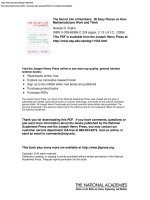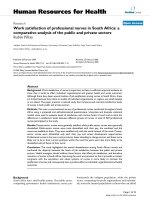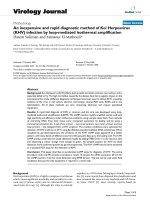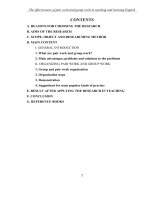Method of Plastering work and Brickwork
Bạn đang xem bản rút gọn của tài liệu. Xem và tải ngay bản đầy đủ của tài liệu tại đây (353.66 KB, 9 trang )
COFICO
1- GENERAL :
This method includes specification of material; brick works and plastering works procedure;
moistureproofing for brick wall; plan for quality control, safety and environment conservation.
This method to be applied to all brick works, plastering works in the Crowne Plaza Nha Trang
Hotel & Residences.
2- REFERENCE:
Specifications of MAPS section 04210: block work and brick work, section 09200: lath and
plaster.
TCVN 4085-1985: masonry structures – codes for construction, check and acceptance.
TCVN 1450-1986, 1451-1986: Clay hollow brick, Clay burnt brick.
TCVN 1770-1986: Sand for construction- technical requirements.
TCVN 4506-1987: Water for concrets and mortars - Technical requirments
TCVN 4033-1985: Cement portland–puzolan.
TCVN 4459-1987; 4314 - 2003: Guidance for mixing and using of building mortars.
TCVN 303-2006: Finishing works in construction – execution and acceptance, part II
TCVN 5674-1992: Finishing works in construction – execution and acceptance.
3- MATERIAL:
All kind of materials for brick works and platering works should be approved first:
Sand: local cleaning yellow sand (Dien Tho)
Cement: Portland PC40 cement from Luks or Holcim
Water: from public water supply system
Dowel: plain round rebar diameterr 6mm.
Epoxy to embed dowel into RC column: Epoxy with 2 components.
(samples to be submitted later)
Trellis: with stitch 10x10mm. (samples to be submtted later)
Method of brick works and plastering works
3
COFICO
Mortar: grade 75 (7.5 MPa), with flowability 165-205mm as per approved mix design.
Mortar
grade
Cemnet type
Cement
(kg)
River sand
(m3)
Water
(kg)
Luks (PCB40)
285
0.96
275
Holcim PCB40)
313
0.98
274
Luks (PCB40)
309
0.99
297
Holcim (PCB40)
322
0.99
287
75
75
Remark
Using for brickwork
(flow: 165-195 mm)
Using for plastering
work (flow: 175-205
mm)
Brick: Tunnel clay brick from Hoa Khanh or Khanh Hoa Co.
Strength: >= 7 MPa, absorbsion < 25% by mass.
Types of bricks: 4 hole hollow brick: 80 x 80 x 180mm
6 hole hollow brick: 115x80x180mm
Solid brick: 40 x 80 x 180 mm
HOLLOW BRICK
HOLLOW BRICK
SOLID BRICK
4- Technical specification:
Method of brick works and plastering works
4
COFICO
4.1 For brickworks:
Brick wall should be flat in horizontal, plumb in vertical, perpendicular in corrner, full, equal and
alternate in mortar joint, thickness of mortar joint should not exceed 12mm.
The location of the brick wall should follow the marking line which has been specified in slab,
column, beam or corewall as per construction drawings.
4.2 For plastering works:
Surface should be smooth and flat, without partially roughness, deviation is < 3mm when
checked with 3m ruler.
Surface should be without scratch, without mortar drops, without indentation caused by
plastering tools
5- Mock-up of brick wall:
Before proceeding brick works, plastering works on a large scale, contractor should build mock
ups for all types of brick walls, show out all connections between brick wall with concrete structure,
lintels and piers.
The mock-ups should be built on site with dimension of 2x1.5m and these mock-ups will show
out requirements of the designer and will be the basic comparative samples for approval to actual on
site brick works and plastering works.
6- Preparation:
Preparing shop drawings for approval.
As soon as formwork of R.C structure taken off, clearing all unnessarry things to install
barricade, safety mesh for the areas of construction.
Mobilizing enough cement, sand, brick... to the site to ensure works can be carried out
continuously without interruption. Maintain, arrange, and cover material in storage carefully;
especially, cement should be stored in dry areas to prevent contact with moisture and water; sand and
brick should be stored on strong and clean areas. Distribute enough material to each floor or each
working area as scheduled.
Arrange enough workers and suitable safety device for the working areas to ensure works can be
carried out continuously.
Arrange areas to store material, mortar mixing, walkway for workers and material carry to
working areas for convenience.
Install temporarily water supply system for mortar mixing, power supply system to each floor or
each working area.
Arrange mortar mixers 150 – 350 litters, material gauge box and mortar tray to working areas
Method of brick works and plastering works
5
Mechanical mixer
MORTAR TRAY
COFICO
Arrange enough equipment and tool to working areas: hand trowel, hand float, level ruler, ruler
2m, 3m, plumb, tape, scaffoldings, wheel barrow, mortar tray and drilling tool...
45°
Mixing yard plan
Section A-A
Mortar mixes
A
Slab
floor
45°
Method of brick works and plastering works
A
Mortar tray
Mortar tray
45°
6
COFICO
7- Sequence of brick works:
Method of brick works and plastering works
7
COFICO
Level
Column
At first, setting out guide lines which are parallel and offset from the grid line on the slab,
columns and beams; Next setting out the boundery of the wall, location of the doors, windows and
other openings (if any) based on these guide lines.
Carrying brick and other material to the right locations to build brick wall and soak the brick into
water for minimum 30 minutes before using to build the wall.
Installing the scaffoldings if necessarry, the scaffolding is 0.1-0.2m apart from the wall.
Drilling hole and embed dowel at the connection between brick wall and R.C structure by Epoxy,
Dowel is plain round rebar with 6mm diameter @ 0.6m, Dowel is 360mm long with the length
300mm in the brick wall and 60mm remaining in concrete structure (column, pier or core wall) as the
sketches for typical detail of brick wall attached.
Cleaning and then plastering cement slurry as bonding agent on the surface between brick wall
and concrete structure to increase adhesive and moistureproofing future.
Well-mixed mortar with flowability 165-195mm to be carried to the working areas and stored in
mortar tray; mortar mixed with water over 1 hour must not be applicable.
Proceeding brick works from bottom to top, main wall first, secondary wall later, external wall
first, internal wall later. Maximum height of each building stage is 1.5m.
Method of brick works and plastering works
8
COFICO
Checking at least 2 times the flatness, straightness, and angle of wall within each height of 0.50.6m, correcting if leaning detected.
Bonding of brick walls 100mm, 150mm, 200mm, 250mm, 300mm, 350mm, 400mm, 450mm,
500mm shown in the attached drawings of typical detail for brick wall.
Where the wall contacts the soffit of beam, the top course brick must be placed slanted and
filled mortar to void in order to prevent cracks caused by concrete shrinkage.
Get touch to top
And bottom surface
Beam/slab bottom surface
Top of wall to be placed
and get fill settlement
Installing rebar and formwoks and then concrete for lintel on top of door and window openings
with the both ends embedded 300mm into brick wall.
Installing door frame (if available)
Installing rebar and formworks for vertical stiffener and horizontal beam and then concreting.
Method of brick works and plastering works
9
COFICO
For brick wall 100mm, 200mm with span >3m, 4m, there should be vertical stiffener, distance
between 2 vertical stiffeners is 3-4m. Detail of vertical stiffeners as shown in construction drawing
S-003.
For brick wall 100mm, 200mm with height >3,5m, 4m there should be horizontal beam,
distance between 2 horizontal is 3.5m, 4m. Detail of horizontal beam as shown in construction
drawing S-003.
When finished, soft broom should be used for cleaning.
Covering carefully or installing barricade to stop any movement can affect to fresh-built brick
wall.
For curing after finished, using water to keep the wall damp in 1 day.
Internal checking and correcting defects (if any).
Request AIC engineer to check and accept.
8- Sequence of plastering works:
2 days after brick works finished, and after AIC’s engineer approved the wall as well as
installation of embeded system (electrical, communication, phone cable, internet, water supply,
waste water…) then the plastering works can start.
Cleaning dirt (if any) on the plastering surface, filling all the gaps with mortar and then flattening
smoothening, applying cement slurry to increase adhesive feature for the concrete
Making the plastering surface damp.
Installing the scaffoldings, working platform (if any).
Fixing datum point made by broken brick with mortar, datum point has the square shape
50x50mm and the thickness is equal to the thickness of plastering layer. Fixing the datum points at
the top and wall end first, and then the points in the middle later, plumbing from the upper points to
fix the middle and lower points, Distance between these datum points is around 1.5-1.8m.
Brickwall
Plumb line
Datum point
Slab level
Method of brick works and plastering works
10
COFICO
Fixing trellis with the stitch 10x10 mm to cover the joint between brickwall and concrete
structure, each side 125mm.
Mixing mortar with the flowability 175-205 mm then carry to working area and stored in the
tray.
Plastering from top down to bottom; plastering the ceiling, beam and wall first then column
later with 5-8mm thickness for each plastering coat. Firstly rendering mortar on the surface,
waiting until the mortar layer becomes dry then rendering the finish coat, lastly using ruler and
hand float to make the surface flat and smooth. In case the plastering layer is too thick then we can
separate it into some coats, each coat is about 5-8 cm and after finishing the first coat, the surface
must be roughened to increase adhesive ability for the next coat, if the surface is too dry it must be
watered before rendering the next coat
24 hours after finishing, start curing by watering or keeping it damp in 1 day.
Internal checking and correcting defects (if any).
Request AIC engineer to check and accept.
9- Quality control:
All materials come to the site should be checked by eye and have material delivery inspection.
Periodically, samples should be taken to do testing at laboratory with the witness of AIC engineer.
Quality of brick works and plastering works should be checked and inspected as specification
and approved drawings.
10- Safety and environment conservation:
Everybody on site should be well- equipped with safety devices: helmet, shoes, clothes, safety
glass and gloves (if necessary). Further, safety belt should be equipped when working at high level.
Every workers should conform to safety measures when building wall, especially when working
on scaffoldings, working at high level there must be safety corridor; working with external wall
there must be safety mesh to prevent falling objects.
Cleaning mortar dropped on floor at the end of working time
Absolutely conform to site regulations for safety and environment conservation.further, safety
officials and staffs regularly check and popularize regulations for safety and environment
conservation to everybody.
11- Inspection and acceptance:
Document for appoval:
Material Delivery Inspection Form (attached in appendix1).
Minutes of check and inspection (attached in appendix1).
Appendix1: Document for approval.
Appendix 2: Drawings for typical details of brick wall.
Appendix 3: Site organization chart.
Appendix 4: Site plan.
Method of brick works and plastering works
11









